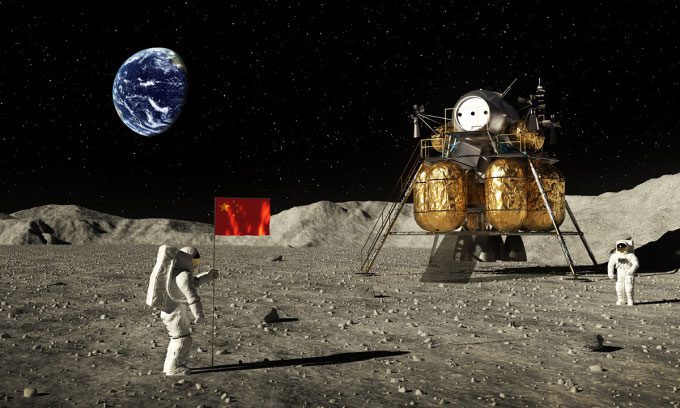In the new mission, the orbital spacecraft and lander will be launched into space, coordinating with each other to deliver astronauts to the Moon.
Zhang Hailian, deputy chief engineer of the China Manned Space Agency (CMSA), revealed new details about the moon landing plan at an aerospace summit in Wuhan on July 12.

Illustration of astronauts planting the Chinese flag on the Moon. (Photo: 3DSculptori/Stock/Getty).
The mission, scheduled to take place before the end of 2030, is part of a larger project aimed at establishing a research station on the Moon. Zhang indicated that the mission will explore the best methods for constructing the station, conducting lunar exploration, and carrying out various other experiments.
During the mission, two rocket launches will place the lander and the crewed spacecraft in lunar orbit. The two will dock together, allowing Chinese astronauts aboard the spacecraft to transfer to the lander, the vehicle used to touch down on the Moon’s surface. On the Moon, the astronauts will collect samples and conduct scientific exploration. Subsequently, they will depart from the lander, re-dock with the spacecraft in orbit, and use it to return to Earth.
To prepare for the mission, Chinese researchers are working hard to develop all necessary equipment, including spacesuits, crewed rovers, crew transport vehicles, and the lander. The number of astronauts expected to be sent to the Moon has not yet been disclosed.
The moon landing mission represents the latest advancement in China’s efforts to develop its space program. Although it lagged behind in the space race—launching its first satellite into orbit in 1970 while the U.S. had already sent astronauts to the Moon—it is rapidly advancing.
In 2013, China successfully landed a rover on the Moon, becoming the third country to achieve this milestone. In 2019, China became the first nation in the world to land a spacecraft on the far side of the Moon. By 2020, the country further succeeded in becoming the third nation to collect lunar samples.
China has also dedicated recent years to building its own space station, named Tiangong. The main T-shaped structure of the station was completed in November of last year. When the International Space Station (ISS) is expected to retire in 2030, Tiangong could become the only operational space station in Earth orbit. China also aims to open its space station for international collaboration, ready to conduct experiments from other countries.


















































